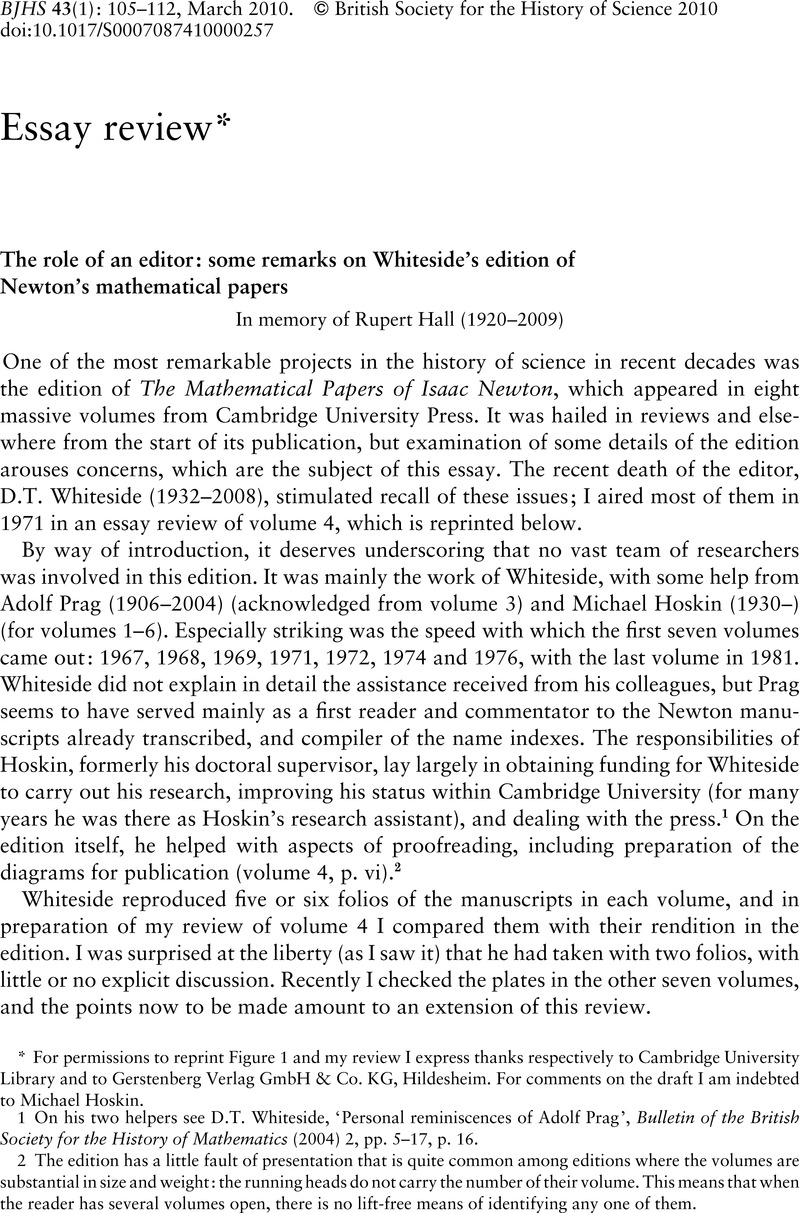No CrossRef data available.
Article contents
The role of an editor: some remarks on Whiteside's edition of Newton's mathematical papers*
Published online by Cambridge University Press: 09 March 2010
Abstract

Information
- Type
- Essay Review
- Information
- Copyright
- Copyright © British Society for the History of Science 2010
References
1 On his two helpers see D.T. Whiteside, ‘Personal reminiscences of Adolf Prag’, Bulletin of the British Society for the History of Mathematics (2004) 2, pp. 5–17, p. 16.
2 The edition has a little fault of presentation that is quite common among editions where the volumes are substantial in size and weight: the running heads do not carry the number of their volume. This means that when the reader has several volumes open, there is no lift-free means of identifying any one of them.
3 See E. Knobloch, ‘L'Edition critique des manuscrits mathématiques leibniziens’, in E. Giusti and L. Pepe (eds.), Edizioni critiche e storia della matematica, Pisa: ETS Editrice, 1986, 85–108, especially the horror-filling folios reproduced on pp. 94, 96 and 97.
4 For a rather monstrous example involving a forest of cancellations big and small and cancellations of cancellations, see my ‘“In some parts rather rough”: an unknown manuscript version of Stanley Jevons's “General mathematical theory of political economy” (1862)', History of Political Economy (2002) 34, pp. 685–726.
5 Whiteside also stated that few people were interested in editorial matters; true, but more fool them! In response to the comment in my review that the price of the volume had increased much relative to its predecessors but that at £18.00 (or $55.00) it was still ‘remarkably cheap’, he informed me that the volumes ‘sold at a loss (if not too large a one)’ and that a ‘cheap price’ of that volume would be ‘£30 or more’.
6 W.W. Rouse Ball, ‘A Newtonian fragment relating to centripetal forces’, Proceedings of the London Mathematical Society (1891–1892) 23, pp. 226–31.
7 A.R. and M.B. Hall, Unpublished Scientific Papers of Isaac Newton, Cambridge: Cambridge University Press, 1962, pp. 65–68, with discussion on pp. 13–14.
8 Namely the Chronological Edition of C.S. Peirce (1982–, Indiana University Press) and the Collected Papers of Bertrand Russell (1983–, now Routledge). For a survey of several editions of mathematical manuscripts see Giusti and Pepe, op. cit. (3); Whiteside did not take part.
9 Whiteside cited Rouse Ball and the Halls in volume 6, p. 589, and criticized their interpretations of the text. This is a different issue, which I do not raise here.
10 This feature is discussed at some length in N. Guicciardini, ‘In memoriam Derek Thomas Whiteside (1932–2008)’, Historia mathematica (2009) 36, pp. 4–9. Contrary to the caption on p. 4, Whiteside is pictured there with Joseph Needham.
11 Let us hope that owners of the volumes have preserved the dust jackets, for, as Whiteside told me, he wrote the descriptions that are printed there.
12 I. Grattan-Guinness, essay review of volume 4, Rete (1971–1972) 1, pp. 195–198.

